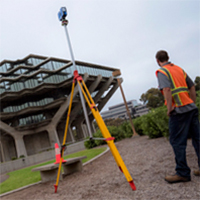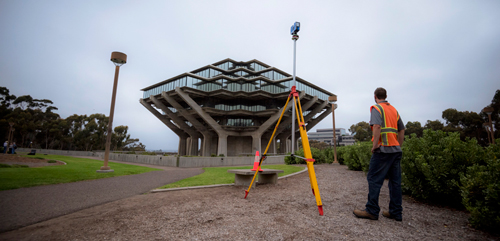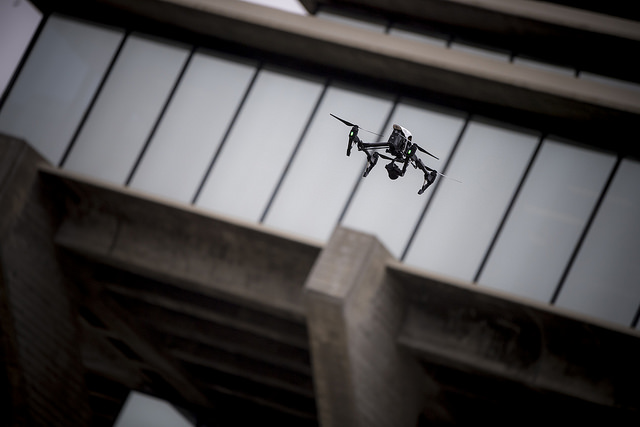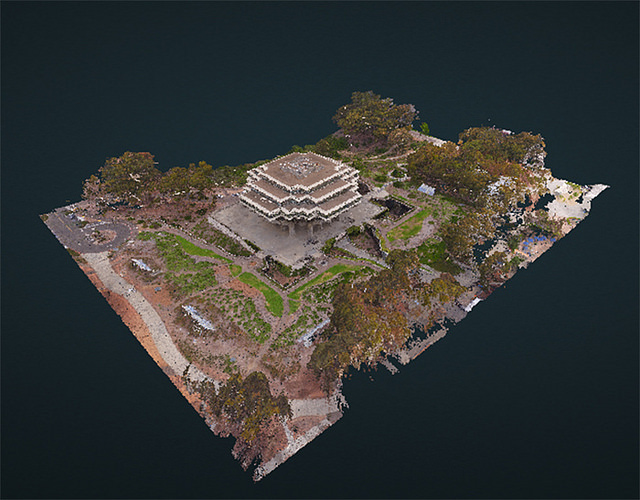
A team of researchers from across UC San Diego is developing a new approach for detecting damage to buildings during earthquakes and other extreme events.

record of Geisel Library. Photos by Erik Jepsen/UC San Diego
They came together at the Geisel Library recently to use lasers and drones to create a digital record of the structure that will serve as a baseline health assessment. In the event that a sizeable earthquake hits nearby, the team will reconvene to retake the digital measurements and assess any damage to the building such as tilting or cracks. (View photo gallery.)
The information is intended to provide both researchers and emergency responders with more detailed information on how structures respond during the earthquakes—beyond the simple visual inspection of buildings currently in use—prior to allowing them to reopen.
According to researchers at the Scripps Institution of Oceanography and Jacobs School of Engineering at UC San Diego who are spearheading the project, the iconic library is the perfect location to begin what they hope will become an effort to digitize the entire campus.
“We are using this culturally significant building on campus as a reference model to help detect structural changes over time,” said Falko Kuester, a professor of structural engineering and CSE faculty-affiliate who serves as director of the Qualcomm Institute's Cultural Heritage Engineering Initiative (CHEI) and DroneLab.

For Yehuda Bock, a distinguished researcher and director of the Orbit and Permanent Array Center at Scripps Oceanography, the primary motivation for the recent survey of Geisel Library was to integrate structural monitoring into his early-warning prototype system for earthquakes and tsunamis.
“Our system tracks ground motions at a millimeter level of accuracy,” said Bock. “This allows us to detect large earthquakes within the critical first minute before the shaking begins.”
Six months ago, Bock equipped the Geisel Library with sensors that continuously measure ground motion from the many faults that crisscross Southern California. The technique he helped pioneer, called seismogeodesy, relies on a combination of GPS receivers and accelerators to very rapidly pinpoint the location and magnitude of strong earthquakes—6.0 magnitude or greater—before the hazardous trembling begins.
The late-July project involved nearly two hours of drone flights led by CHEI researcher Eric Lo, capturing more than 1,000 high-resolution images of the Geisel Library that will be turned into a photorealistic model of the structure. Lo’s drone survey was accompanied by a several-hour ground survey by professional land surveyor Richard Maher using lidar (light detection and ranging), an instrument that sends pulsating laser lights at an object to provide a precise 3-D model. By combining these techniques, the team will create a geometrically as well as visually detailed and accurate final model.

captured by drones and used structure-from-motion
techniques to create a 3D computer model of Geisel
Library and its surroundings.
Bock’s GPS sensors provide a precise 3-D reference to tie together the high-resolution drone and lidar imagery, allowing for the accurate detection of subtle permanent displacements of the structure’s outer shell as a measure of its integrity after an event.
Kuester currently leads research teams developing drone technology for crisis management and response, as well as applying the work to study and help preserve ancient Mayan structures in Mexico, Neanderthal caves in Italy, and shipwrecks and coral reefs in Bermuda. For him, this project is a first step to create a digital surrogate or as he calls it, a “cyber-twin” of the campus, before new buildings and bridges transform the campus’s physical appearance in the future.
Although Kuester often looks at ancient buildings and ruins, he points out that “it’s important to also document modern buildings before the perils of time or extreme events cause them to deteriorate or create an even less fortunate outcome.”
The digital record on the condition of buildings as they exist today provides a baseline for comparison in the future as a building ages, or in the case of a fire, earthquake or other natural hazard, actionable data, according to the researchers, to swiftly respond and mitigate risks.
.jpg)
Engineering Initiative ran the drone photography project.
Within a few minutes of completing the drone flights, Lo had a quick 360-degree rotating view of the geometrically shaped building from the images collected during the flights for view in 3-D.
Another important motivation for Bock and Kuester is to have students involved in real-world research projects, both on site and as classroom teaching tools.
“As an educator, it’s important that I expose my students to real-world conditions,” said Falko. “The contribution to science needs to be useful and usable.”
Kuester and Lo will also be turning the drone imagery into a virtual reality experience for those interested in flying themselves around the outside of the library.
Bock and Kuester are hoping the project will attract more interest and funding to seismically monitor and digital archive all buildings throughout the UC San Diego campus.
Meanwhile, at Bock’s lab at Scripps Oceanography, the seismic monitoring data is continuously streamed back in real-time. When the next powerful quake strikes, the system will alert him first of the primary signal, called a P-wave, which indicates an earthquake has taken place, and that the destructive S-wave, the one responsible for the strong earth-shaking, is seconds to minutes away. The GPS and seismic sensors on the Geisel Library will quickly indicate whether it has suffered significant shaking and displacement.
For Bock and Kuester, how these buildings and others respond to outside influences is an important component to how we better prepare as a society for extreme events in the future.

